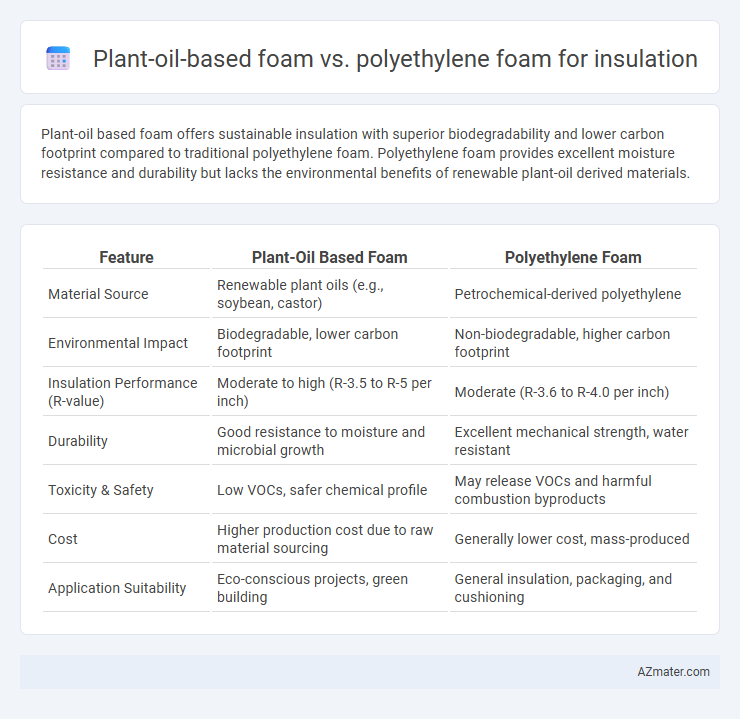Plant-oil based foam offers sustainable insulation with superior biodegradability and lower carbon footprint compared to traditional polyethylene foam. Polyethylene foam provides excellent moisture resistance and durability but lacks the environmental benefits of renewable plant-oil derived materials.
Table of Comparison
| Feature | Plant-Oil Based Foam | Polyethylene Foam |
|---|---|---|
| Material Source | Renewable plant oils (e.g., soybean, castor) | Petrochemical-derived polyethylene |
| Environmental Impact | Biodegradable, lower carbon footprint | Non-biodegradable, higher carbon footprint |
| Insulation Performance (R-value) | Moderate to high (R-3.5 to R-5 per inch) | Moderate (R-3.6 to R-4.0 per inch) |
| Durability | Good resistance to moisture and microbial growth | Excellent mechanical strength, water resistant |
| Toxicity & Safety | Low VOCs, safer chemical profile | May release VOCs and harmful combustion byproducts |
| Cost | Higher production cost due to raw material sourcing | Generally lower cost, mass-produced |
| Application Suitability | Eco-conscious projects, green building | General insulation, packaging, and cushioning |
Introduction to Plant-Oil Based and Polyethylene Foams
Plant-oil based foam utilizes renewable, biodegradable components derived from natural oils such as soy or castor, offering enhanced environmental sustainability compared to traditional materials. Polyethylene foam, a synthetic polymer made from ethylene gas, provides excellent moisture resistance, durability, and thermal insulation properties. Both foams serve essential roles in insulation, with plant-oil variants emphasizing eco-friendly composition while polyethylene foams prioritize long-term performance and resilience.
Chemical Composition and Origin
Plant-oil based foam insulation derives primarily from renewable triglycerides found in soy, castor, or other vegetable oils, offering a bioderived polymer matrix with fewer volatile organic compounds (VOCs) and greater biodegradability. Polyethylene foam is synthesized from petrochemical-based ethylene monomers, resulting in a robust, inert, and hydrophobic polymer with superior resistance to moisture but reduced environmental sustainability. The chemical composition of plant-oil foams often includes polyurethane derived from natural polyols, whereas polyethylene foams consist of long-chain hydrocarbons formed through polymerization of ethylene.
Production Processes Compared
Plant-oil based foam insulation utilizes renewable bio-based materials derived from crops such as soy or castor oil, involving a chemical reaction that creates a foam structure through natural polyols and isocyanates. Polyethylene foam production relies on the polymerization of ethylene, followed by a physical or chemical blowing process that introduces gas bubbles to form a closed-cell structure, often using non-renewable fossil fuels. The plant-oil foam process offers a lower carbon footprint and reduced reliance on petrochemicals compared to the energy-intensive polyethylene foam manufacturing.
Thermal Insulation Performance
Plant-oil based foam exhibits superior thermal insulation performance due to its low thermal conductivity, typically ranging between 0.030 to 0.035 W/m*K, compared to traditional polyethylene foam which averages around 0.040 W/m*K. The cellular structure of plant-oil based foam enhances heat retention and reduces energy transfer, making it an eco-friendly alternative with improved insulation properties. Its renewable origin and biodegradability also contribute to sustainable building practices without compromising thermal efficiency.
Environmental Impact and Sustainability
Plant-oil based foam insulation offers a significantly lower carbon footprint compared to traditional polyethylene foam due to its renewable biomass source, reducing reliance on fossil fuels. Biodegradability and compostability of plant-oil foam contribute to less landfill waste and minimized environmental pollution, whereas polyethylene foam persists for hundreds of years, exacerbating plastic pollution. Moreover, plant-oil foams often incorporate non-toxic, low-VOC formulations, enhancing indoor air quality and supporting sustainable building certifications like LEED and WELL.
Cost and Market Availability
Plant-oil based foam insulation typically offers a competitive cost advantage over polyethylene foam, especially as sustainable materials become more in demand, though initial production costs can be higher due to raw material sourcing. Market availability of polyethylene foam remains broader and more established, with widespread use in construction and packaging, while plant-oil based foams are gaining traction in niche eco-friendly markets and expanding as bio-based alternatives increase in production capacity. Cost efficiency and supply chain maturity favor polyethylene foam currently, but ongoing advances in biofoam manufacturing are narrowing the gap significantly.
Durability and Lifespan
Plant-oil based foam insulation offers enhanced environmental benefits with comparable durability to traditional polyethylene foam, exhibiting resistance to moisture, mold, and UV degradation. Polyethylene foam typically provides a longer lifespan due to its inherent chemical stability and resistance to physical wear over time. When evaluating insulation longevity, polyethylene foam often outperforms plant-oil based alternatives, though advancements in bio-based foam formulations are closing the durability gap.
Applications in Construction and Industry
Plant-oil based foam offers superior sustainability and enhanced thermal insulation properties compared to polyethylene foam, making it ideal for green building projects and eco-conscious industrial applications. Its biodegradability and lower carbon footprint benefit construction sectors aiming to meet LEED certification and environmental regulations. Polyethylene foam remains preferred for cost-effective, moisture-resistant applications such as pipe insulation and packaging, where durability and chemical resistance are critical.
Health and Safety Considerations
Plant-oil based foam insulation offers superior health and safety benefits by reducing exposure to toxic chemicals such as formaldehyde and volatile organic compounds (VOCs) commonly found in polyethylene foam. Its natural, non-toxic composition minimizes respiratory irritation and allergenic reactions, making it suitable for indoor environments with strict air quality requirements. Unlike polyethylene foam, plant-oil based foam is often biodegradable and less flammable, enhancing fire safety and environmental sustainability in building applications.
Future Trends and Innovations in Foam Insulation
Plant-oil based foam insulation is gaining traction due to its renewable origins and lower environmental impact compared to traditional polyethylene foam, which relies on fossil fuels. Future trends emphasize enhanced bio-based foam formulations with improved thermal resistance and fire retardancy, leveraging advances in green chemistry and nanotechnology. Innovations are also driving the development of fully biodegradable and carbon-negative foam insulation products, aligning with global sustainability goals and stricter building codes.

Infographic: Plant-oil based foam vs Polyethylene foam for Insulation
 azmater.com
azmater.com